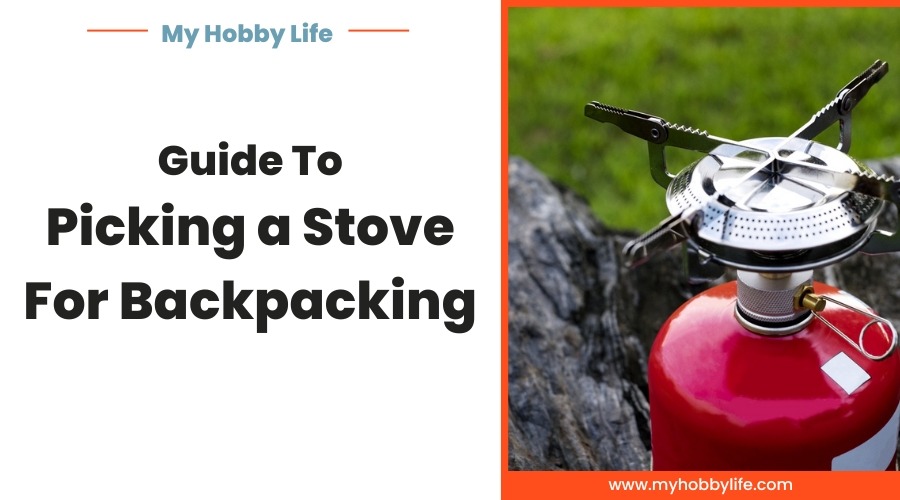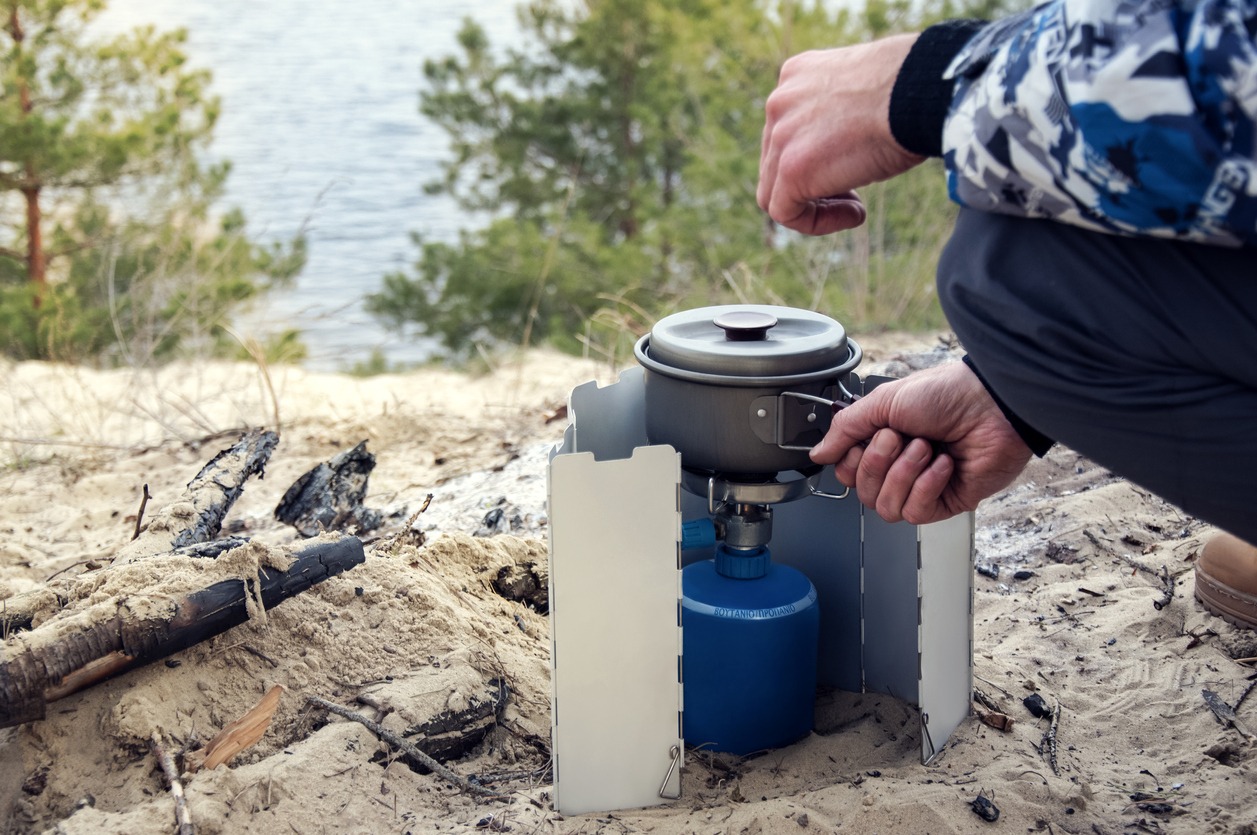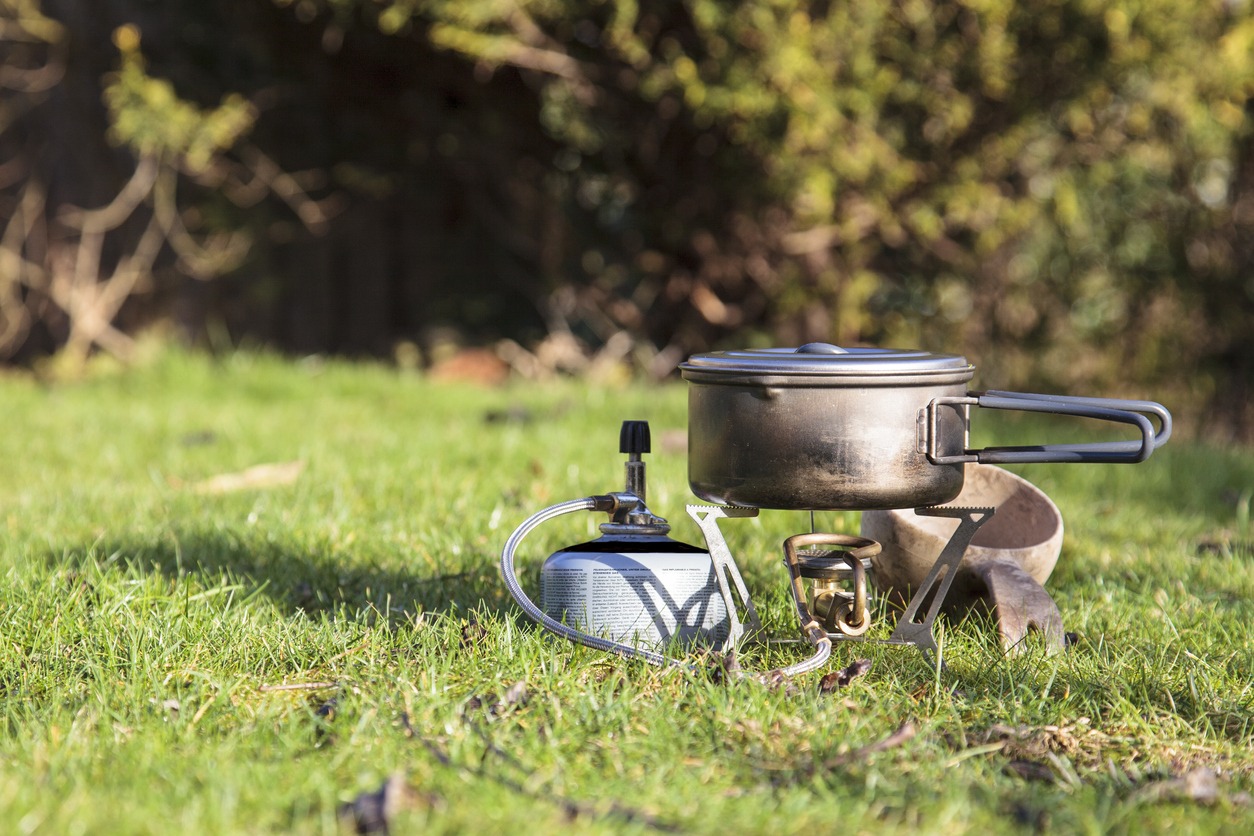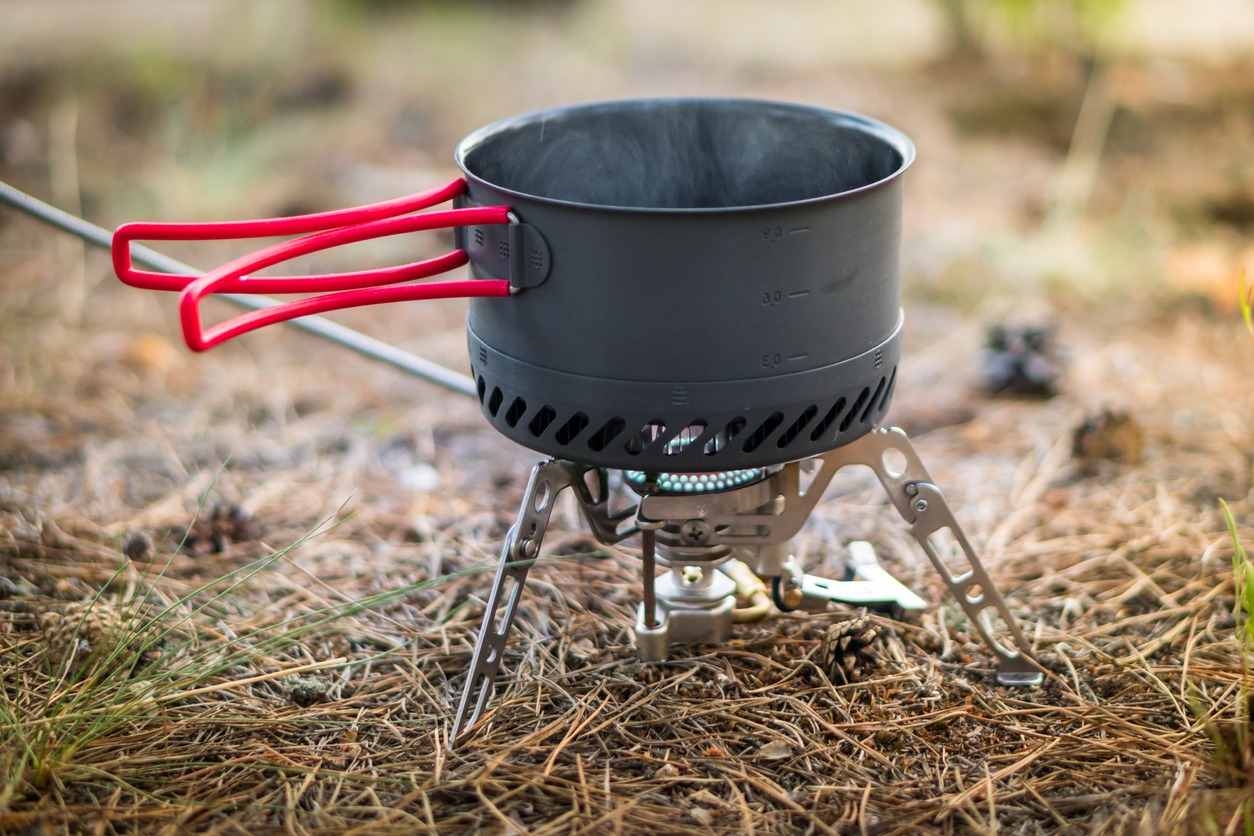If you’re backpacking on the off-the-beaten path and intend to eat food other than merely protein energy bars, nuts, seeds, or dried fruits, a reliable stove system is a must in your gear. A stove can help you boil your water, make a cup of coffee, or prepare a warm, nutritious meal while under a snowbank or rainy hillside, fueling you for your adventurous exploits and keeping your spirits high.
Just note that the perfect stove doesn’t exist. Like with other backpacking essentials, the “best” item depends heavily on a variety of factors, such as your personal inclinations, budget, destination, and the environment. Here, skip all the jargon, outline all the necessary information, and discuss all vital aspects involved when picking a stove for backpacking, helping you get to the bottom of what may be the best stove for you.
Types of Stoves
1. Small Canister Stoves
Small canister stoves are the most common type of stove – one that you’ll most likely see carried by backpackers. They’re named after the small isobutane fuel can that these stoves screw directly into using a Lindal valve. Ideal for modern-backcountry cooking, small canister stoves are lightweight and simple and best for small groups consisting of 1-3 people who need to boil water for coffee, tea, oatmeal, or dehydrated meals. Though you can cook more complex meals with some small canister stoves, be wary that they’re mostly intended for simmering due to their stability and pot size.
PROS:
- Small and lightweight
- Fast boil time
- Plug-and-play, easy to use
- Adjustable flame
- Fuel isn’t liquid so there are no spills
CONS:
- Less stable as they sit and depend on the fuel canister
- Poor wind resistance
- Not suitable for larger pots due to the small arms
- Not repairable once it’s broken or once it malfunctions
2. Integrated Canister Stoves
Integrated canister stoves are tall-profile cooking systems that incorporate the stove and cup into a more streamlined system. They feature a burner that fastens onto the fuel can and pairs effortlessly with an insulated, twist-on cooking pot and a lid with a drain hole and/or sip/pour hole. Generally, these stoves are specifically designed to have super quick boil times (not for cooking), which they efficiently do because of the built-in windscreen. As such, they are also ideal for windy environments or when you’re anxious about the weather.
As it’s a full cook system, integrated canister stoves are your best bet if you want to buy a single item that has everything you need instead of buying the part separately. Just be mindful that while they have better fuel efficiency than standard small canister stoves, the integrated system is heavier, more expensive, and more prone to tip-overs.
PROS:
- Super quick boil time
- Better fuel efficiency than their standard counterparts
- All-in-one system
- Great wind resistance due to the built-in windscreen
CONS:
- More costly
- Heavier
- Unstable, wobbly due to tall profile
- Intended for boiling water quickly and not for cooking real food
3. Remote Canister Stoves
As their name suggests, remote canister stoves have a canister that sits far away. It uses a fuel hose that connects to the canister and keeps the fuel away from the stove. Thus, allowing the stove to sit on the ground by itself instead of nestling above the canister.
Remote canister stoves also don’t offer the same cool setup as integrated canisters, which is why they aren’t a preferred choice by backpackers in their backcountry trips. Not to mention that they are also heavier, more expensive, and less compact than standard small canister stoves. Still, they fit such activity as they have great wind resistance due to windscreen compatibility and wider arms for larger-pot stability.
PROS:
- Super stable
- Use of windscreen is possible as the canister is away from the stove
- Great in cold weather as some models allow inversion of fuel canister to make a liquid stove on the fly
- Suitable for real cooking
- Wider base that fits larger pots and pans
CONS:
- Heavier
- More expensive
- Less compact
4. Liquid-fuel Stoves
All liquid-fuel stoves use white gas. It is thoroughly refined to have few to zero impurities, allowing it to burn hot and clean and perform well even in below-freezing temperatures.
Some models are multi-fuel, meaning they can also run on all or some of the following: kerosene, diesel, unleaded auto gasoline, and even jet fuel. Such fuel versatility makes them an excellent option for international backpackers who may encounter limited fuel choices.
Yet, like with anything traditional, there are a few aspects of liquid-fuel stoves that have already been outrun by the latest advancements in technology. They are pretty heavy and involve many pieces. The stove itself is already hefty, but it still comes with a hose, heat reflector, windscreen, bottle and pressure regulator, and other small parts for cleaning. If you’re a backpacker that counts ounces of your gear, liquid-fuel stoves can be too much.
Moreover, most liquid fuel systems have a slower boil time and are not known for their simmering capability. They can also be loud, as they have a tendency to roar. Though some models incorporated sound dampeners, the loudness was not fully mitigated.
Lastly, liquid-fuel systems require a learning curve as most require priming before use and also need periodic maintenance, such as replacing the O-rings in the stove and the fuel bottle and cleaning the fuel hose.
Though there are such drawbacks, there’s some break in the clouds. Compared to canister fuel, liquid-stove fuel is cheaper per ounce. They have greater stability and are field repairable and fuel-efficient, so you’ll still see old-school backpackers carrying them or those going on longer treks and exploring the alpines.
PROS:
- Field repairable
- Versatile (lots of fuel options)
- Fuel efficient
- Great stability
- Performs well in high elevation and cold temperatures
CONS:
- Heavy, have many pieces
- Slow boil time
- Loud
- Fuel spills are possible
- Priming and regular maintenance required
- Multi-fuel stoves can be expensive
- Steep learning curve
5. Alternative-fuel Stoves
Alternative-fuel stoves are a growing category that includes stoves that run on alcohol, wood, or fuel pellets. These stoves are ideal options for long-distance backpacking, with each of them also having its own advantages and downsides.
A. Alcohol Stoves
In the backpacking world, alcohol stoves are the most basic stove around. They specifically run on denatured alcohol, which is widely available at most auto parts stores and gasoline stations. Unlike white gas, denatured alcohol evaporates quickly in case it spills on your gear and won’t leave any lasting odor.
These stoves are also extremely cheap and lightweight, making them very popular among ultralight and budget-conscious backpackers. While alcohol stoves are available for purchase, most backpackers build their own by using soda cans and other materials. That means that the stove can actually cost nothing unless you wish to buy ones made of titanium.
The drawbacks of alcohol stoves are slow boil time (takes 7-10 minutes to boil water), inability to control heat output (making it hard to do other types of cooking beyond boiling water), and limitation to single fuel use. Moreover, these stoves won’t perform well in inclement weather, requiring supplemental items like a windscreen for them to do better.
PROS:
- Inexpensive (or no cost at all if DIY)
- Extremely lightweight
- Uses denatured alcohol, which is very easy to find
- Don’t break
- Fuel burns quietly
CONS:
- Does not burn as hot as other types of fuel
- No flame control
- Super slow boil time
- Single fuel use
- Don’t perform well in bad weather
- Using a windscreen is often a must
B. Wood-Burning Stoves
Wood-burning stoves are entirely what they sound like, they are designed for burning wood. Though they aren’t as light as other types of alternative-fuel stoves, they can still be pretty light, weighing only around 4 ounces. Yet, what’s great about them is that you no longer need to carry any fuel, meaning you actually cut down on weight. You just pick up twigs, pine cones, sticks, barks, buffalo chips, leaves, and other combustible materials along the way, and you’re ready to cook!
On the downside, if the area you’re visiting recently experienced rain, it may be quite difficult or worse, impossible to find dry fuel. Should you find any, it can also be difficult to control its heat, making them fit only for boiling water and not for real cooking. Be also cautious as some locations implement a fire ban, which means it’s prohibited to use this type of alternative-fuel stove there.
PROS:
- Simple
- Lightweight
- Some models can function as an optional grill
- No need to carry fuel
CONS:
- Finding dry fuel can be challenging during wet weather
- Prohibited in some areas due to burn ban
C. Solid-Fuel Tablet Stoves
Solid-fuel tablet stoves use tablets made of flammable compounds, which were initially developed as a portable fuel source by the military. These stoves are lightweight and have a simple design that folds out and supports a pot. You place the tablets inside, light them, and they will burn for about 10-12 minutes, which is enough to boil a cup of water.
While they are among the cheapest backpacking stoves you can get in the market, they have a few snags. They have a slow boil time, and you can’t adjust the heat output. Moreover, the tablets sometimes have an odor and may leave residue on the underside of your pots and pans.
PROS:
- Simple design
- Cheap
- Lightweight, compact size
- Tablets light quickly and can be reused
CONS:
- Slow boil time
- Tablets may sometimes have an odor
- Tablets may leave a greasy residue on cookware
Though these alternative systems are not as powerful as their canister or liquid gas counterparts, they are rising in popularity among minimalist and ultralight backpackers.
Factors to Consider When Picking A Stove For Backpacking
Being aware of the different types of stoves is only one part of the decision-making process. You need to weigh different factors in order to find the best backpacking stove for you. These factors include:
1. Weight
One of the primary considerations when picking a stove for backpacking is weight. After all, you’d be carrying all the essentials in your backpack, and you’d want to cut down on weight as much as possible so it won’t weigh and slow you down.
This is particularly crucial on multi-day trips as you want to preserve your energy until the end of your adventure and not get easily exhausted in the early parts of your pursuit just because you’ve brought a backpack that’s too heavy.
Thankfully, the industry has leaned towards making gear smaller and lighter, even on backpacking stoves. To give you an idea, here is the general weight range of different backpacking stoves:
- Small Canister Stoves: 2-8 ounces
- Integrated Canister Stoves: 14-18 ounces
- Remote Canister Stoves: 6-8 ounces
- Liquid Fuel Stoves: 10-18 ounces
- Alcohol Stove: 1-2 ounces
- Wood Burning Stoves: 2-32 ounces
- Solid-fuel Tablet Stoves: 1-3 ounces
Be wary that while the weight of the stove is important, you also need to factor in the weight of the fuel and how much fuel you need for your entire trip. You may save weight by carrying a lighter stove, but if you have to bring heavier fuel, it may not be the smartest choice. Plus, you also want to have a stove that isn’t only lightweight but can cook the type of meals you’re accustomed to and the number of people you’re with.
2. Packability and Nesting
Apart from weight, another concern is packability. There’s no point in bringing a lightweight model if you’ll just experience difficulties fitting in the corners of your backpack. Like most backpackers, look for a model that can collapse or fold up like origami so you can easily nest them inside your pot or bowl setup. What you’ll love is that manufacturers are releasing smaller and more foldable year by year. To give you an insight, here’s how different stove types pack down and nest:
Small Canister Stoves: Very small pack size, eats up small space, and easy to pack
Integrated Canister Stoves: Bigger than the small canister stoves but are still relatively small, designed for full systems,
Remote Canister Stove: Largest among the canister stove family, may fold, relatively small, difficult to nest because of the fuel hose
Liquid Fuel Stoves: Large, hard to pack down due to many parts, often needs a separate carrying case, don’t nest easily
Alcohol Stoves: Tiny, can fit or nest anywhere
Wood Burning Stoves: Varies greatly depending on the model. Small ones can usually pack down flat and can nest anywhere inside your pack; high-end modes are typically large and don’t nest easily
Solid-fuel Tablet Stoves: Always small, pack down flat and nest easily
3. Fuel Efficiency
There are many aspects to look at if a backpacking stove is designed to be efficient. The more efficient a backpacking stove is, the faster the boil time, the more lightweight it is, and the less fuel you need to carry. To check a stove’s fuel efficiency, you need to ask a few questions: is the stove’s heat directed onto the pan and the pan only? Does it come with a suitable wind guard? How long can it run on at full heat using your chosen fuel? All that accounts for a better, more efficient backpacking stove.
4. Speed to Boil
Most backpackers want hot water early in the morning or a sumptuous dinner after a long tiring day after. In general, most backpacking stoves can boil a cup of water in four to six minutes, but some stoves have a faster boil time than others. If you want a quick boil time, then you should opt for a small canister stove. If you wish to make things even faster, then getting an integrated canister stove is your best bet.
If you don’t mind time and wish to carry a lightweight stove, then consider getting an alcohol stove. However, if you don’t want to hear your buddies complaining about being hungry or cold, steer away from alcohol stoves. Be wary that aside from the type of stove, you should also be taking factors like altitude, wind, and weather as they can significantly hinder or slow boiling time.
5. Simmering Capability
Having a super quick boil time is handy. However, if you don’t like to eat your entire trip by adding hot water to your noodles, another vital feature to consider is the stove’s simmering capability. Many backpacking stoves can boil water but perform poorly in more sophisticated dishes. To cook other types of foods, you’d want your stove to have effective simmer control or precise flame control at a low setting. Just because you’re exploring the great outdoors doesn’t mean that you have to compromise on cooking performance. Trust us, eating great food can do wonders for you by giving the much-needed boost for your trip.
6. Wind Resistance
Regardless of whether you are backpacking, one thing is for sure: backpacking stoves don’t like windy conditions. Be in a windy location, and the wind can be an instant meal-killer. It will easily blow off your flame, drag boil time, and decrease fuel efficiency. As bad weather is unavoidable, your best solution is to get some wind protection.
While integrated canister stoves already perform well on a moderately gusty day, alternative-fuel stoves (alcohol, wood-burning, and solid-fuel tablet) perform poorly. To increase your stove’s performance from the strong winds, find models with built-in windscreens. An exception to this is the small canister stoves, as the fuel canister can easily heat up once confined.
Though windscreens aren’t a cure-all remedy, given that strong winds can come from all directions, placing your stove in a relatively protected spot while using the windscreen can help you get a stable flame.
7. Ignition
Backpacking stoves will commonly require you to light them manually using a flame source. Yet, some models are equipped with a Piezo ignition system, which lets you simply press a button or flip a lever to create a spark.
Having an ignitor has a few advantages, such as being very easy to use, keeping your hand away from the burner, and saving you time and effort from fiddling with matches, especially on a windy day on the mountainside. Sounds great, right?
However, the Piezo ignition usually increases the cost, adds weight, and tends to become less reliable over time. That means that you will still be bringing spare matches and/or a backup lighter anyway, even if you choose to have a Piezo ignition – something you need to think through when weighing your options.
8. Stability
Knocking your cooked meal onto the ground can quickly turn your day into a disastrous one. So, if you intend to prepare larger meals using a big pot, strive to get a good stove that has a broad base and stand that will nest securely on the ground. Remote canister stoves are one of the most stable stoves you can get. If you picked a small or integrated canister stove instead, note that you can only use small pots on them, and they still tend to be less stable, so devote extra caution when cooking.
9. Durability
Does the backpacking stove need to be handled with the utmost care, or will it still function even if you don’t care for it like a baby? Does it have many little moving parts that can quickly get lost? Will its parts become crooked or bend as you love to work tough on your gear? Will dirt, dust, sand, and other debris easily clog the cooking system? Does it have parts that can snag off? Is it easy to clean and maintain? Get answers to these questions, and you can quickly assess if your desired backpacking stove will only last you a few trips or one that you can bring for more adventures to come.
10. Noise
Some backpacking stoves roar or cook loudly, while others work silently. If you don’t want to disrupt conversations of other people, ruin your experience in nature, or bother wildlife around, they shoot for a quiet backpacking stove. Just be mindful that tolerance and sensitivity to noise vary per individual. So, choose one with a resulting noise that you can bear. In general, liquid fuel stoves are the loudest, while alcohol-burning stoves are the quietest.
11. Cost
Backpacking stoves’ price point varies widely. You can find cheaper, simpler units at around $10, while premium ones can go up to $200 or higher. Generally, less expensive stoves aren’t as efficient, reliable, and fast compared to more costly models, but they will get the job done. The decision boils down to how much you’re actually willing to spend and how much you’ll be using your backpacking stove. If you don’t mind shelling out money and you’re into more serious backpacking pursuits, then you can opt for more premium models. If you’re a casual backpacker who needs a backpacking stove for a short overnight hike, then you may not need to spend that much, or you can even just make a DIY stove instead.
12. Fire Restrictions
Though they can vary, fire ban rules exist in some places. That’s why it’s important to first check the specific regulations in the area. Some locations implement stricter fire restrictions and prohibit all types of stove usage. Others are less strict and allow canister stoves and solid-fuel tablet stoves. Alcohol and wood-burning stoves are usually not allowed. Meanwhile, liquid-fuel stoves can be permitted, but with extra caution, especially during priming, as highly flammable liquid fuel may spill and quickly start a fire. Again, don’t miss out on checking the rules in the area to avoid getting into trouble.
Takeaway
The best backpacking stove differs from one person to another. Make sure to take all the factors and information above to find the ideal backpacking stove for your adventures. After all, you only deserve to eat a hot meal and drink a hot cup of coffee while relishing all the spectacular views in the great outdoors. Happy backpacking!



